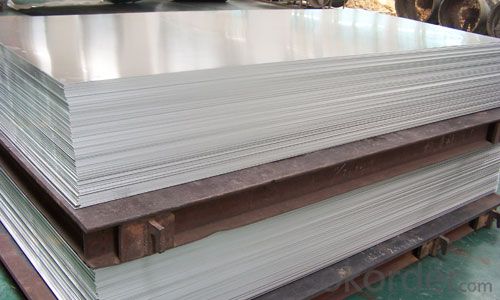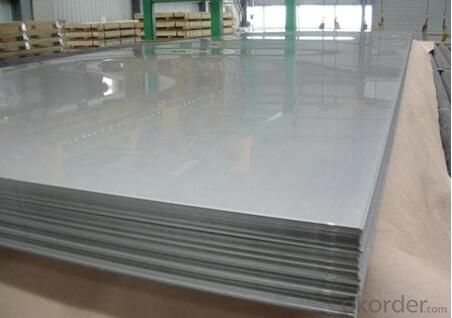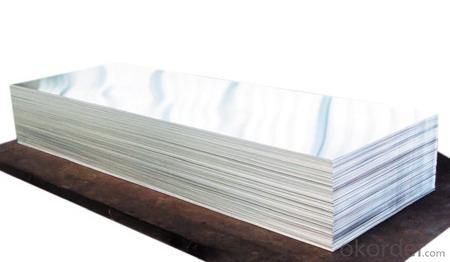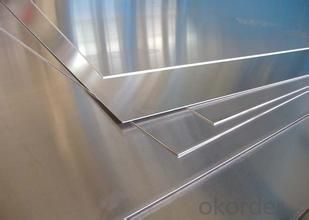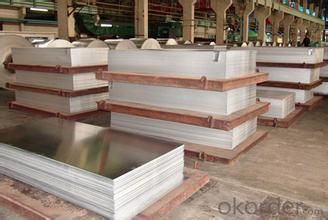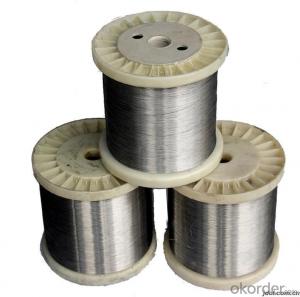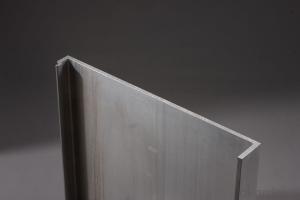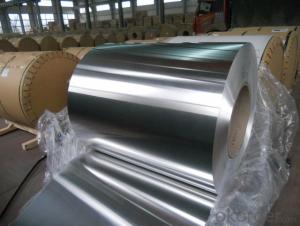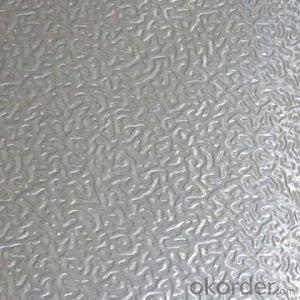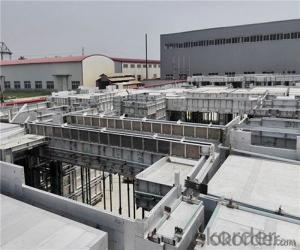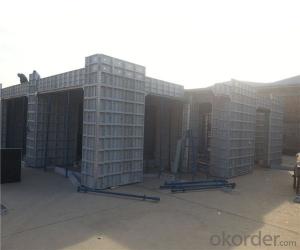Perforated Reflective Aluminum Sheet for Aluminum Concrete Formwork
- Loading Port:
- Shanghai
- Payment Terms:
- TT OR LC
- Min Order Qty:
- 8 m.t.
- Supply Capability:
- 20000 m.t./month
OKorder Service Pledge
OKorder Financial Service
You Might Also Like
Specification
1.General Information
Aluminum sheets is between 0.1 mm and 500mm in thickness and has a wide variety of uses in the construction industry including aluminium siding and roofing. Sheet is also used widely in construction, decoration, transport applications and other various industrial filed, such as automobile body panels, airframes, curtain walls and the hulls of boats etc.
We produces aluminum sheets which meets the highest standards in its own mill while save the cost. Our strong quality control term bring you the most-qualified products. Our aluminum complying with YS/T 429-2000(Chinese Industry Standard),GB/T 3880,EN485,ASTM B209.
The main producing procedure includes the following steps:
Rolling--Annealing--Slitting--Sawing, Cut-To-Length, Shearing
2. Technical Data
Alloy
AA1050,AA1060, AA1070, AA1100
Temper:
H12, H14, H16, H18, H22, H24, H26, H32,HO, F
Thickness:
0.10-500mm
3.Dark green surface, color changed into light green after exposure.
Image checked easily.
4.Surface Quality :be free from Oil Stain, Dent, Inclusion, Scratches,
Stain, Oxide Dicoloration, Breaks, Corrosion, Roll Marks, Dirt Streaks
and other defect which will interfere with use
5.Faithful reproduction capacity, result at clear images.
6.Highly durable, long impression available.
7.Excellent sensitive character.
8.Resolution : 2%-98%
9.Material:1050/1060/1070/1100/2A16/2A06/2A12/2024/3003
3A21/4A01/5052/5005/5083/5A05/6061-T6/6063-T5/6082/7021
7075-T6/8011,etc
10.Certificate: ISO9001:2000, SGS and ROHS(if client request, paid by client),
MTC(plant provided), Certificate of Origin(FORM A, FORM E, CO)
11.Packing:First, plastic cloth; Second, Pearl Wool ; Third, wooden cases
with dry agent ,without fumigation,wooden pallets
12.Application:Aircraft, automobile, train,Building wall, ceilings,
roofing, furniture cabinet, lighting plate,etc
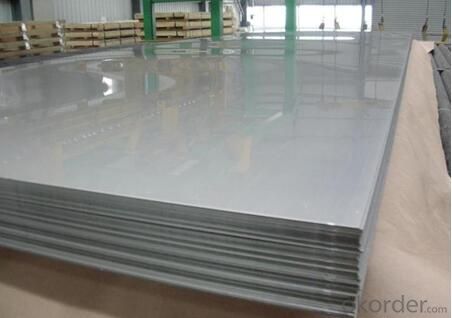
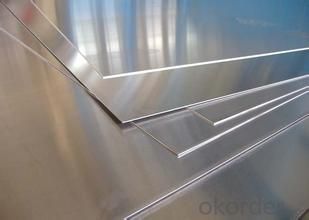
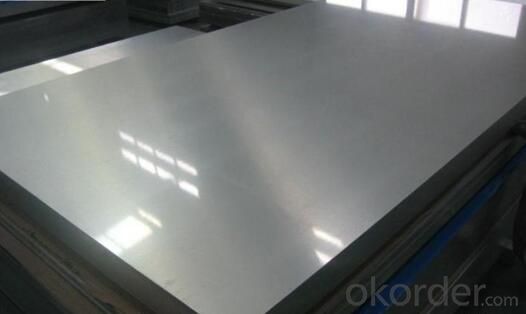
- Q: What is the typical impact strength of aluminum sheets?
- The impact strength of aluminum sheets can differ depending on the alloy and temper of the material. Nevertheless, when compared to other metals, aluminum sheets generally possess a relatively lower impact strength. This is due to the fact that aluminum, being a lightweight material, lacks the strength and durability of steel or other alloys. To measure the impact strength of aluminum sheets, one typically determines the energy required to cause the material to fracture or deform, which can be expressed in joules or foot-pounds. Although specific values may vary, the impact strength of aluminum sheets typically falls within the range of 10 to 40 joules or 7 to 30 foot-pounds. It is worth noting that factors such as thickness, surface condition, and the presence of surface treatments or coatings can influence the impact strength. Therefore, it is advisable to consult the manufacturer's specifications or conduct specific tests to ascertain the impact strength of a particular aluminum sheet.
- Q: Can aluminum sheets be used as heat shields?
- Yes, aluminum sheets can be used as heat shields. Aluminum has excellent thermal conductivity, meaning it can efficiently conduct and transfer heat away from the source. Additionally, aluminum has a high melting point, allowing it to withstand high temperatures without warping or deforming. These properties make aluminum sheets an ideal choice for heat shield applications, such as protecting sensitive components or structures from heat damage in various industries including automotive, aerospace, and industrial applications. Furthermore, aluminum is lightweight and relatively easy to shape, making it a practical choice for heat shields that need to be installed in tight spaces or require complex designs. Overall, the use of aluminum sheets as heat shields offers effective thermal protection while providing durability, versatility, and cost-effectiveness.
- Q: How do you prevent distortion of aluminum sheets during welding?
- To prevent distortion of aluminum sheets during welding, there are several key measures that can be taken: 1. Proper joint preparation: Ensuring that the edges of the aluminum sheets are properly cleaned and beveled before welding is crucial. This helps in achieving a better fit-up and minimizes the chances of distortion. 2. Fixture and clamping: Using appropriate fixtures and clamps to hold the aluminum sheets in place during welding can help to restrain and distribute the heat more evenly. This helps in reducing the risk of distortion by preventing the sheets from moving or buckling due to thermal expansion. 3. Tack welding: Prior to performing a full weld, tack welding can be done at regular intervals along the joint. This helps in temporarily fixing the sheets in place and distributing the heat, allowing for more controlled cooling and minimizing distortion. 4. Welding sequence: Applying a proper welding sequence can also help in preventing distortion. It is recommended to start welding from the center and gradually move towards the edges, alternating between sides. This helps in balancing the heat input and minimizing distortion by allowing the welded sections to cool down before the next weld is performed. 5. Preheating and post-weld heat treatment: For thicker aluminum sheets, preheating the material before welding can help to reduce the temperature gradient and minimize distortion. Additionally, post-weld heat treatment can be applied to relieve residual stresses and promote dimensional stability. 6. Welding technique: Employing appropriate welding techniques such as using a lower heat input and slower travel speed can help in minimizing distortion. Additionally, using a smaller weld bead size and avoiding excessive weaving can also help to control the heat input and reduce the chances of distortion. 7. Proper weld parameters: Ensuring that the welding parameters such as voltage, current, and wire feed speed are properly set and maintained is crucial. Using the correct parameters for the specific aluminum alloy being welded can help to achieve a more controlled heat input, minimizing distortion. By implementing these preventive measures, the risk of distortion during aluminum sheet welding can be significantly reduced, resulting in improved weld quality and dimensional stability.
- Q: Can 101 aluminum sheets be used for roofing or siding?
- Yes, 101 aluminum sheets can be used for roofing or siding. Aluminum is a popular material for both roofing and siding due to its durability, lightweight nature, and resistance to corrosion. The use of aluminum sheets for roofing or siding provides a long-lasting solution that can withstand harsh weather conditions and requires minimal maintenance. Additionally, aluminum sheets are available in various thicknesses, including 101, allowing for flexibility in design and structural needs.
- Q: What is the fatigue limit of aluminum sheets?
- The fatigue limit of aluminum sheets varies depending on various factors such as the alloy, thickness, and surface condition. However, aluminum alloys generally exhibit a relatively high fatigue limit compared to other materials, making them suitable for applications where cyclic loading is involved.
- Q: This question asks for methods to determine the thickness of aluminum sheets.
- <p>To measure the thickness of aluminum sheets, you can use various methods including mechanical thickness gauges, ultrasonic thickness gauges, or calipers. Mechanical gauges are simple and involve sliding a foot along the sheet until it bottoms out on both sides. Ultrasonic thickness gauges use sound waves to measure thickness and are non-destructive, providing accurate measurements. Calipers can also be used for manual measurement, though they may be less precise for very thin sheets. Always ensure the measuring device is calibrated and suitable for the material and thickness range of the aluminum sheet in question.</p>
- Q: What is the thickness range available for aluminum sheets?
- The thickness range available for aluminum sheets can vary depending on the specific requirements and applications. Generally, aluminum sheets can be found in a wide range of thicknesses, ranging from as thin as 0.006 inches (0.15mm) to as thick as 0.5 inches (12.7mm) or even thicker in some cases. However, it is important to note that the availability of specific thicknesses may vary depending on the supplier or manufacturer. Additionally, custom thicknesses can often be obtained through specialized fabrication processes.
- Q: This question asks for criteria or factors to consider when selecting a high-quality aluminum sheet.
- <p>To choose a quality aluminum sheet, consider the following factors: 1) Thickness and weight, which should meet your specific project requirements. 2) Surface finish, ensuring it's smooth and free from defects. 3) Purity and alloy type, as different alloys have different properties. 4) Certifications, ensuring the sheet meets industry standards. 5) Supplier reputation and customer reviews for reliability. 6) Price, ensuring it's reasonable for the quality. 7) Conductivity and strength, depending on your application. 8) Corrosion resistance, important for longevity. Always inspect the sheet for any visible defects and ensure it's from a reputable supplier.</p>
- Q: Are aluminum sheets suitable for use as materials for windows and doors?
- <p>Yes, aluminum sheets can be used for windows and doors. They are known for their durability, low maintenance, and resistance to corrosion and weathering. Aluminum windows and doors are energy-efficient, lightweight, and offer excellent security. They can also be easily customized in terms of size and design, and are often used in modern architecture for both residential and commercial buildings.</p>
- Q: What is the difference between the alloy 1060H24 aluminum plate and the alloy 1100H24 aluminum plate?
- At present, most of the circulation in the market is 1050 and 1060 series. 1000 series aluminium plate to determine the minimum aluminum content in this series according to the amount of the last two Arabia figures, such as the 1050 series of the last two Arabia number 50, according to the international brand naming principles, content must reach 99.5% to the top for qualified products. China's aluminum alloy technology standard (gB/T3880-2006) is also clearly defined, 1050 aluminum content of 99.5%., the same reason, 1060 series aluminum plate aluminum content must reach more than 99.6%
Send your message to us
Perforated Reflective Aluminum Sheet for Aluminum Concrete Formwork
- Loading Port:
- Shanghai
- Payment Terms:
- TT OR LC
- Min Order Qty:
- 8 m.t.
- Supply Capability:
- 20000 m.t./month
OKorder Service Pledge
OKorder Financial Service
Similar products
Hot products
Hot Searches
Related keywords







